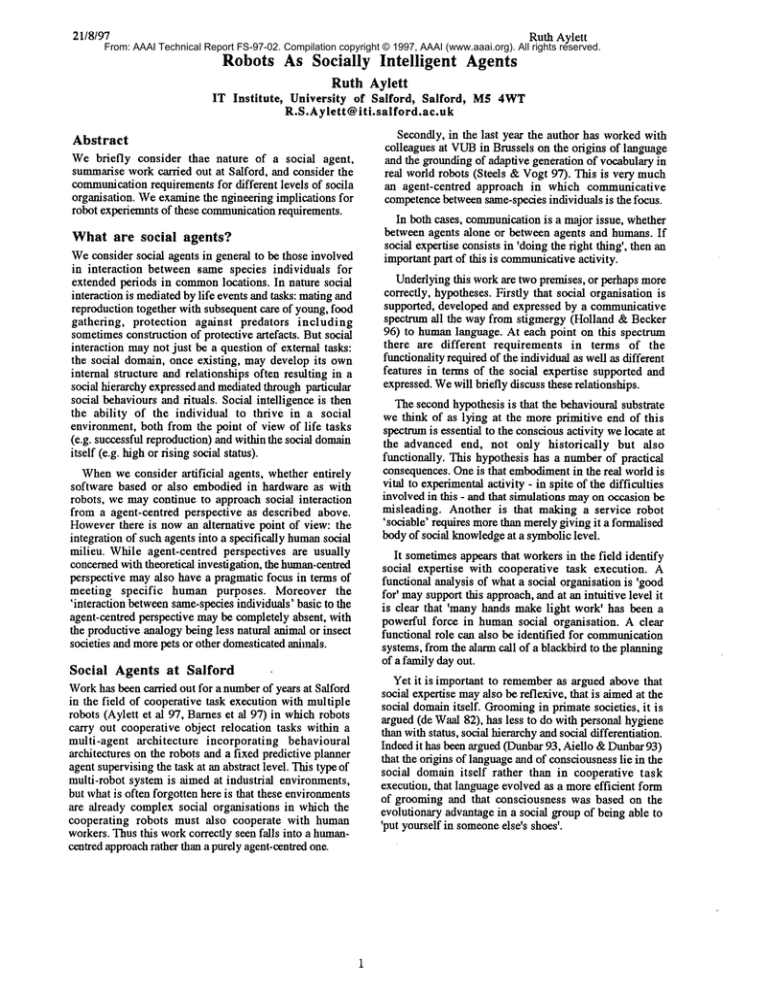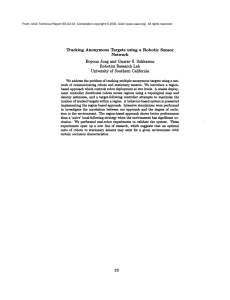
21/8/97
Ruth Aylett
From: AAAI Technical Report FS-97-02. Compilation copyright © 1997, AAAI (www.aaai.org). All rights reserved.
Robots As Socially
IT Institute,
Intelligent
Agents
Ruth Aylett
University of Salford, Salford, M54WT
R.S.Aylett @iti.salford.ac.uk
Abstract
Webriefly consider thae nature of a social agent,
snmmariseworkcarried out at Salford, and consider the
communication
requirementsfor different levels of socila
organisation. Weexaminethe ngineering implications for
robot experienmtsof these communication
requirements.
What are social agents?
Weconsider social agents in general to be those involved
in interaction between same species individuals for
extended periods in commonlocations. In nature social
interaction is mediatedby life events and tasks: matingand
reproduction together with subsequentcare of young, food
gathering, protection against predators including
sometimesconstruction of protective artefacts. But social
interaction maynot just be a question of external tasks:
the social domain, once existing, maydevelop its own
internal structure and relationships often resulting in a
social hierarchy expressedand mediatedthroughparticular
social behavioursand rituals. Social intelligence is then
the ability of the individual to thrive in a social
environment, both from the point of view of life tasks
(e.g. successful reproduction)and within the social domain
itself (e.g. highor rising social status).
Whenwe consider artificial agents, whether entirely
software based or also embodiedin hardware as with
robots, we maycontinue to approach social interaction
from a agent-centred perspective as described above.
Howeverthere is nowan alternative point of view: the
integration of such agents into a specifically humansocial
milieu. While agent-centred perspectives are usually
concernedwith theoretical investigation, the human-centred
perspective mayalso have a pragmatic focus in terms of
meeting specific human purposes. Moreover the
’interaction betweensame-speciesindividuals’ basic to the
agent-centred perspective maybe completelyabsent, with
the productiveanalogybeing less natural animalor insect
societies and morepets or other domesticatedanimals.
Social Agents at Salford
Workhas beencarded out for a numberof years at Salford
in the field of cooperative task execution with multiple
robots (Aylett et al 97, Barneset al 97) in whichrobots
carry out cooperative object relocation tasks within a
multi-agent architecture incorporating behavioural
architectures on the robots and a fixed predictive planner
agent supervisingthe task at an abstract level. Thistype of
multi-robot system is aimed at industrial environments,
but whatis often forgotten here is that these environments
are already complexsocial organisations in which the
cooperating robots must also cooperate with human
workers.Thusthis workcorrectly seen falls into a humancentred approachrather than a purely agent-centredone.
Secondly, in the last year the author has workedwith
colleagues at VUBinBrussels on the origins of language
and the groundingof adaptive generation of vocabularyin
real world robots (Steels &Vogt97). This is very much
an agent-centred approach in which communicative
competencebetweensame-speciesindividuals is the focus.
In both cases, communication
is a major issue, whether
between agents alone or betweenagents and human.~. If
social expertise consists in ’doingthe fight thing’, then an
importantpart of this is communicative
activity.
Underlyingthis work are two premises, or perhaps more
correctly, hypotheses.Firstly that social organisation is
supported, developed and expressed by a communicative
spectrum all the way from stigmergy (Holland & Becker
96) to humanlanguage. At each point on this spectrum
there are different requirements in terms of the
functionality requiredof the individual as well as different
features in terms of the social expertise supported and
expressed.Wewill briefly discuss these relationships.
Thesecondhypothesisis that the behaviouralsubstrate
we think of as lying at the more primitive end of this
spectrumis essential to the consciousactivity welocate at
the advanced end, not only historically
but also
functionally. This hypothesis has a numberof practical
consequences.Oneis that embodiment
in the real worldis
vital to experimentalactivity - in spite of the difficulties
involvedin this - and that simulations mayon occasionbe
misleading. Another is that making a service robot
’sociable’ requires morethan merelygiving it a formalised
bodyof social knowledge
at a symboliclevel.
It sometimesappears that workersin the field identify
social expertise with cooperative task execution. A
functional analysis of whata social organisation is ’good
for’ maysupportthis approach,and at an intuitive level it
is clear that ’manyhands makelight work’ has been a
powerful force in humansocial organisation. A clear
functional role can also be identified for communication
systems, fromthe alarmcall of a blackbirdto the planning
of a familyday out.
Yet it is important to rememberas argued above that
social expertise mayalso be reflexive, that is aimedat the
social domainitself. Grooming
in primate societies, it is
argued (de Waal82), has less to do with personal hygiene
than withstatus, social hierarchyandsocial differentiation.
Indeedit has beenargued (Dunbar93, Aiello &Dunbar93)
that the origins of languageand of consciousnesslie in the
social domainitself rather than in cooperative task
execution, that languageevolved as a moreefficient form
of grooming and that consciousness was based on the
evolutionary advantagein a social group of being able to
’put yourself in someone
else’s shoes’.
The robot dimension:
Whatdoes the investigation of social expertise using real
robots require of the real robots? At the bottomend of the
communicative
spectrum,it requires the ability to use the
environmentas a communicativemechanism.It is at this
level that mostexisting workis being carried out since it
is possible to produceand perceive stimergic effects with
extremelyprimitive actuation and perception mechanisms.
For example,the cooperatingrobots in the workat Salford
are able to jointly carry an object using force feedback
from the object rather like two people carrying a table
(Barnes96). Theyrequire no ability to differentiate each
other from the rest of the environment,a factor one could
argue is inherent in stigmergy as a mechanism.This lack
of differentiation meansthat hierarchyin this sort of social
organisation is almost entirely functionally determined:if
a beeis a dronethen it cannotbe a queen.
Even at this level, modes of interaction with the
environmentare usually fairly primitive, particularly if
robots are comparedto social insects for example.Robot
sensory and actuation capabilities meanthat they relate to
the environmentin an inflexible and impoverished way
such that one might seriously question what sort of
’embodiment’is actually achieved. For examplevery few
robots have any compliancein their effectors (an area
mainlystudied in fixed manipulators with someexamples
in multi-legged mobility), which reduces touch sensing
downto the binary values generated by bumpers.The use
of smell wouldrequire cheap but reasonably sensitive
chemicalsensors as well as the incorporationof generation
mechanismsin robots. This is an area that seems hardly
investigatedat all. Soundis also a modalitythat is rarely
used.
Problemsof cost, powerlimitations, and the need to
conservea limited stock of robots rather carefully, rather
than goingin for the large-scale redundancyof individuals
seen in insect societies also havethe effect of constraining
the type of interaction with the environmentavailable. A
robot society which could construct artefacts of the
complexityof termite hills is somewayoff, with flocking
and herding along with wandering and box-pushing the
most commonbehaviours demonstrated using stigmergy.
Manyexperimental systems lack any effectors beyond
(usually) wheelsor (less often, legs). Froman engineering
perspective, we haveyet to construct robots anythinglike
as physicallysophisticatedas ants, slugs or flies.
Species
awareness
Farther along the communicativespectrum robots require
the ability to separateout ’others like me’fromthe rest of
the environment,in other wordsspecies or perhaps merely
social group awareness. Analarm signal, for example,is
an explicit communicationwhich only has meaning to
others of the samespecies or social group. Here there are
further engineeringimplications for robots since species
recognition requires both characteristic features and the
ability to recognise them. A very simple implementation
might be to use the range-finding sensors available on
most robots for obstacle avoidance. Thus, in a simple
artificial environment, other robots maybe the only
sourcesof infra-red or ultra-soundemission.
Unfortunately, the very use of these output devices for
obstacle avoidancemeansthat the perceiving robot has to
stop and turn off its ownemitters in order to makea
distinction betweennew emissions and the return of its
own signals (Steels & Vogt 97). This seems very
restrictive and in a sense misses the point: the difference
between this mode of communicationand stigmergy is
precisely that species or group members can be
distinguished from the environment,not that they can only
be sensedif the environment
is ignored.
A further option is vision (Bdpaeme&Birk 97), but
here the difficulty lies in the demandsit makesupononrobot processing: the amountof data delivered from a
vision system and the computational demands of the
algorithms used tends to lead to unacceptable power
demands and slow processing. On the other hand,
connecting the robot to an external processor severely
impacts its autonomy. Comparingthe sensory equipment
generally available on robots with that available to
animals whouse this type of communicationit appears
that investigation of the other sensory modesalready
mentioned- such as soundand smell for example- and the
combination of small amountsof data from a numberof
different sensors mayprovidea better wayforwardthan the
resource-demanding
use of vision
Individual
recognition
Movingstill further across the communicationspectrum
wearrive at language, whichrequires the establishmentof
individuality (Dautenhalm
95), a yet stronger requirement.
Equippingeach robot with a unique frequencyinfra-red or
ultra-sound transmitter is one possibility, but it also
seemslikely that solving the species recognition problem
throughsensor fusion as suggestedmightlay the basis for
individual recognition too. True, one can always cut
through the problemby incorporating hard-wiredsymbolic
namesand a radio link, but arguably one might just as
well use a simulator as incorporate a deus ex machinalike
this on real robots.
The developmentof individuality implies an extended
’life’ and accumulationof experience (Dautenhahn95)
well as an internal ’bodyimage’- a representation within
the robot of its own material form. Again, this has
engineering implications as well as computingones: an
extendedlife requiresthe ability to rechargebatteries unless
autonomyis vitiated with an off-robot source of power.It
probably also requires the use of static memory
to retain
data throughperiods of powerdrain. This is aside fromthe
challenge of deciding what should be learned using what
algorithmsand what representations. The developmentof a
’body image’ also has sensor implications - the
measurement
of battery level is the only internal sensor on
mobilerobots in most cases with nothing to give data on
the spatial position of bodyparts except for rare cases of
the use of inertial sensors to measureorientation (since the
majority of mobilerobot platforms run on level surfaces
using wheelsthis mustusually appear superfluous).
Conclusion
Whatthis piece has tried to argue is that if one regards
embodimentas important to communicationand thus to
social organisation, it raises a numberof significant
questionsabout the required functionality of robots to be
used in experiments. In practice these are difficult
questions: it is difficult to answer them without
substantial expenseand engineering backup. Weargue that
difficult issues mustbe confrontedat quite primitive levels
of interaction before one can provide the basis for higher
level social interaction. It is perhapsnot surprisingthat so
muchworkis carried out in simulation, but it remainsto
be seen howfar the conclusions of simulatedworkwill be
supportedeventually on real-world robots.
References
Aiello, L. &Dunbar, R.I.M. (1993) Neocortexsize, group
size and the evolnionof language.Current
Anthropology, 34, pp184-93
Aylett, R.S; Coddington,A.M;Barnes, D.P. & Ghaneahercock, R.A. (1997) Supervising multiple
cooperating mobilerobots. Proceedings,
AutonomousAgents ’97, ACMPress, pp 514-5,
1997
Barnes, D.P. (1996) A behavioursynthesis architecture for
cooperant mobile robots. AdvancedRobotics and
Intelligetn
Machines, eds J.O.Gray &
D.G.Caldwell, lEE Control Engineering Series
51.295-314 1996
Barnes, D.P; Ghanea-Hercock,R.A; Aylett, R.S. &
Coddington, A.M.(1997) ’Manyhands make
light work?Aninvestigation into behaviourally
controlled coooperant autonomousmobile
robots’. Proceedings, Autonomous
Agents ’97,
ACMPress, pp 413-20, 1997
Belpaeme,T. &Birks, A. (1997) A real-world ecosystem
featuring several robot species. Proceedings,
European Conference on Artificial Life, ECAL
’97, Brighton, July 1997
Dautenhahn, K. (1995) Getting to know each other
Artificial social intelligence for autonomous
robots. Robotics and AutonomousSystems 16
(1995) pp333-56
Dunbar, R.I.M. (1993) Cocvolutionof neocortical size,
group size and language in humans.Bchavioural
& Brain Sciences, 16 pp681-735
Franklin, S. (1996) Coordinationwithout communication.
Proceedings,
The First UK Workshop on
Foundations of Multi-Agents Systems, FOMAS
’96, pp8-13, University of Waewick,October
1996
Holland, O. & Beckers, R. (1996) The varieties
stigmergy: indirect interaction as a control
structure for collective robotics. Robotica- to
appear
Steels, L. &Vogt, P. (1997) Groundingadaptive language
gamesin robotic agents. Proceedings, Conference
on Artificial Life, ECAL’97, Brighton, July
1997
de Waal (1982) ChimpanzeePolitics: Power and Sex
amongApes. London: Jonathan Cape



